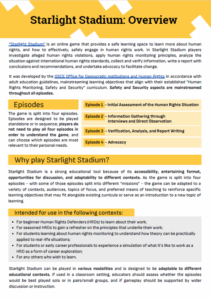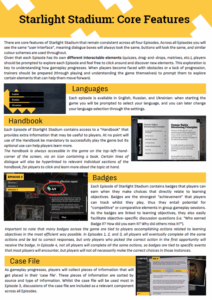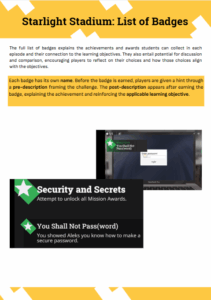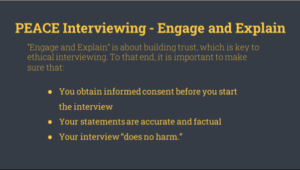The Starlight Stadium game was designed to make training on human rights monitoring more accessible and engaging, providing an interactive way to learn about the monitoring cycle, how to conduct human rights monitoring safely and effectively and to refresh core skills. As educators, trainers or facilitators you can use the game as a flexible teaching tool, whether to provide a comprehensive overview of the monitoring cycle or for targeted training focusing on specific stages and skills. This page provides you with some practical resources that may help you prepare, guide, and adapt gameplay to different training contexts.
Educator’s toolkit


Starlight Stadium: Overview
Presents the game’s concept and episode structure, outlining its purpose and adaptability across different training contexts. Based on the game’s learning objectives, it provides an overview of key training subjects built across all four episodes to help you decide which parts to play. Here, you’ll also find guidance on how the game integrates key human rights monitoring principles.

Starlight Stadium: Core Features and Troubleshooting
A guide through the game’s core features that remain consistent across all four episodes, including different interactable elements that should help you to understand how gameplay progresses. Additionally, this document provides quick solutions to common challenges that may arise during gameplay, ensuring smooth facilitation.






Each episode contains badges players can earn while playing the game. The full list of badges explains the achievements and awards students can collect in each episode and their connection to the learning objectives.



Slide Decks
Ready-to-use presentation slides, designed to provide relevant instruction surrounding Starlight Stadium episodes. You should feel at liberty to use or adapt these slide decks to your own purposes, depending on how the game will be played, and what experience level your students possess. Slide notes offer suggestions for facilitators, supporting the development of structured training sessions and allowing for flexible delivery.


How to Use These Resources?
Each document is designed to stand on its own, while also forming part of the educator’s toolkit. Refer to the Overview to understand the educational approach. Use the Slide Decks to structure your training sessions. Refer to the List of Badges to connect game achievements with learning goals. Keep the Troubleshooting guide on hand for smooth facilitation. As new teaching aids and other materials are being developed, these will be uploaded to this website and continuously expand the toolkit.
Learning Objectives
To complement the toolkit provided above, you are encouraged to draw on the learning objectives as accompanying resources. Each of the four episodes of Starlight Stadium is linked to specific objectives that align with the stages of the human rights monitoring cycle. Referring to these objectives can help reinforce your training sessions or preparations. You can review the learning objectives for each episode below:
Episode 1 – Initial Assessment of the Human Rights Problem
During Episode 1, you will:
- Understand incident security protocols.
- Learn the human rights standards found in some international conventions.
- Understand the nature of State obligation.
- Understand the principles of human rights (universality, inalienability, indivisibility, etc.).
- Understand the concept of limited or absolute rights.
- Learn about passwords, multi-factor authentication, email encryption, and physical security protocols.
Episode 2 – Information Gathering
During the scenes with Mr X, you will:
- Learn about when to use secure communication channels.
- Understand the different steps needed to conduct an interview, including planning and preparing for the interview, engaging with the interviewee, and explaining the interview process.
- Learn about the importance of informed consent.
- Understand when and how to use open-ended questions.
During the scenes with Toni, you will:
- Learn how to select a secure and comfortable location and consider who should be present.
- Learn about the PEACE model of interviewing.
- Encourage an uninterrupted narrative with open-ended questions.
- Understand how to implement a trauma-informed approach to an interview.
- Consider the victims’ needs and refer them to an appropriate service provider.
During the direct observation scenes, you will:
- Understand the importance of a risk assessment and how to undertake one
- Learn about the do’s and don’ts for preparing for an on-site observation.
- Understand how to document not just “what” is happening, but also “who” and “how”.
Episode 3 – Verification, Analysis, Report Writing
During verification, you will:
- Remember that verification is a precondition to analysis and one should never act on information that is not verified.
- Understand how the human rights monitoring principles apply to verification and are interconnected.
- Understand that for information to be verified, one must assess its source reliability, the information’s credibility, its consistency, and its coherence with the broader context.
- Understand it is important to consider the reliability of your sources of information when verifying.
- Be able to acknowledge your own personal biases in verifying (and analysing) information, when assessing how it fits into the context of the situation.
- Understand the various means through which information can be corroborated.
- Appraise information via cross-checking with multiple sources.
- Recall that digital methods can be used to verify information.
During analysis, you will:
- Comprehend the different components of analysis.
- Understand the importance of legality, legitimacy and proportionality tests on determining a human rights violation.
- Understand that the relevant actors/institutions and policies relating to the human rights problems being addressed must be identified.
- Understand the role that contextualisation plays in analysis.
- Understand how to assess the level of responsibility of the duty bearer.
- Understand that it is necessary to identify the legal/normative implications of the human rights problem.
- Understand how to draw conclusions on the human rights issue based on the result of the analysis.
During report writing, you will:
- Be able to effectively structure a human rights report based on six essential sections: Table of Contents, Executive Summary, Methodology, Findings, Recommendations, and Legal Framework.
- Recall the key content that goes into the Executive Summary and Methodology sections of a report.
- Be able to recognize SMART (Specific, Measurable, Achievable, Result-oriented/Relevant, Time-Bound) recommendations.
- Understand that key human rights monitoring principles must be mainstreamed throughout reporting.
- Understand the necessity for source confidentiality.
- Understand the importance of focusing the report on state actions.
- Understand the importance of including an intersectional perspective in your report.
Episode 4 – Advocacy
During Episode 4, you will:
- Get introduced to the definition of human rights advocacy: advocacy involves a wide variety of techniques, including direct or indirect pressure, politeness, humility, showing empathy for the interlocutor, praise and stressing mutual objectives or developing solutions together.
- Understand what stakeholder mapping is and how it can be used for advocacy purposes.
- Learn how to deliver key messages to stakeholders.
- Have the opportunity to implement an advocacy strategy while managing resources and capacity of your team.
- Learn to respond to new risks emerging from the increase of exposure.











